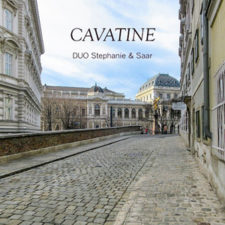
Review by: David Vernier

Artistic Quality: 9
Sound Quality: 9
These things aren’t always a bad idea, or a pointless exercise, or even a not-so-pointless if merely functional effort to supply certain solo-repertoire-hungry instrumentalists (trumpet, guitar, mandolin, accordion–and even piano four-hands) with something new and respectable to play. Transcribing (as opposed to arranging) works for instruments that weren’t originally intended or indicated by the composer is an honored tradition that often yields results that supersede the merely practical, even providing enlightening insights that enable us to hear the original in new, interesting, equally satisfying ways.
Stephanie Ho and Saar Ahuvia are experienced and devoted performers of Beethoven quartet transcriptions for piano four hands, and in an earlier review–of the Duo’s renditions of three of the Op. 18 quartets (see reviews archive)–colleague Jed Distler commented not only on the “skillfully-wrought transcriptions” (by Hugo Ulrich and Robert Wittman) but on the pianists’ “chamber-like aesthetic”, and “refined and intelligent interpretations”, all of which applies to the current performance of Op. 130. (Ho and Ahuvia play Beethoven’s own transcription of the Grosse Fuge.)
Listening to a transcription–especially of a complex work such as this–is certainly more interesting if you already know the original fairly well; you never know when some feature of musical interest you’ve never heard before will suddenly reveal itself! You may hear things that simply increase your appreciation of the original–and the insight and skill of the performers–or, you may hear things that convince you that the original conception works better. For me, I thoroughly enjoyed hearing the familiar themes and noticing how these two players treated textures, articulation, and balances, and how they managed phrasing, especially in sustained melodic passages.
Mostly, it works: thanks to the masterful transcriptions and the sensitivity of the players, particularly regarding clarity of inner voices, we hear the full dynamic and expressive range of this glorious quartet, albeit embodied in the uniform sound of one piano, without the nuance and timbral characteristics unique to four stringed instruments. My one reservation regards the famed Cavatina movement of Op. 130: it misses the sustained tension of the strings, and thus loses much of the movement’s considerable emotional impact. Rather than a smooth, flowing legato, enhanced with espressivo dynamic effects, for some reason Ho and Ahuvia’s approach is square, plodding, and detached.
Of course the Schubert Fantasie D. 940 is not a transcription, and, as one of the composer’s most important four-hand piano works, it’s been recorded many times, probably best overall by Murray Perahia and Radu Lupu. And after the monumental Beethoven quartet, it may be best to leave the Schubert for a separate listening session–the excellent performances by Ho and Ahuvia deserve fresh attention and will certainly reward serious fans of this repertoire. As for the Beethoven, ultimately the questions are, do these works prove suitable for the treatments they receive, and do the transcribers and performers realize their potential, technically and interpretively? On all counts, the answer is definitely “yes”.
Recording Details:
Album Title: Cavatine
Reference Recording: Beethoven Op. 130 (piano four-hands): This one, Schubert D. 940: Perahia & Lupu (Sony)
- BEETHOVEN, LUDWIG VAN:
String Quartet in B-flat major Op. 130 (transcr. for piano 4-hands by Hugo Ulrich & Robert Wittman); Grosse Fuge Op. 134 (transcr. for piano 4-hands by Beethoven)
- SCHUBERT, FRANZ:
Fantasie in F minor D. 940


